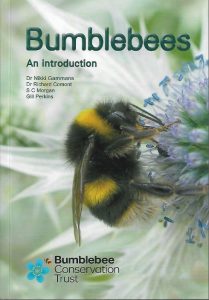Bumblebees, An Introduction. By Nikki Gammans, Richard Comont, S.C. Morgan and Gill Perkins. Bumblebee Conservation Trust. 2018. 174pp.
Edited by four bumblebee experts, this is a major work from eight contributors including the editors. Put together by the Bumblebee Conservation Trust (BCT) it does what ‘it says on the tin’, it is a great introduction, possibly the best introduction to these appealing insects for the general public. The book is extensively illustrated in colour throughout, including the works of 18 photographers including those of entomologist Steven Falk. This book presents a bewildering array of imagery that maps all the finer points of bumblebee biology that make identification easier. The book has seven chapters: introduction, pollination, decline, gardens, collecting, ‘the big seven’ (buff-tailed, white-tailed, red-tailed, common carder, early, tree and heath) and the major chapter on Identification. Bumblebees are here classified into four groups, red tails, ginger tails, yellow tails and cuckoo bees, a refreshing classification that departs from earlier books, but very effect. Each of the 24 extant species of bumblebee (three have already gone extinct) is clearly shown as colour bar diagrams of body bands, photographs in the wild showing particular characteristics (noted and shown on the photographs), life cycle through the months and a distribution map. This is a very exciting compilation and will be a great success for BCT. The book will be thumbed through by eager entomologists, hymenopterists and amateur naturalists – it is small enough to go into a field jacket or knapsack for identification and it has a glossary, index and further information.
